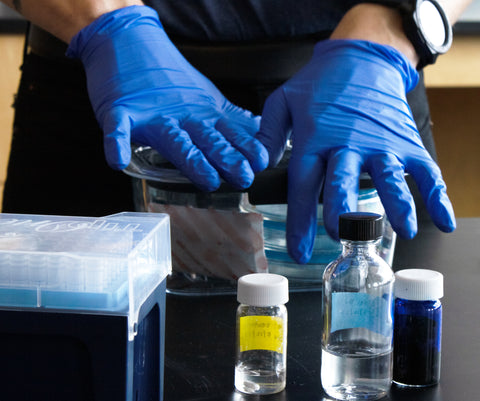QC2 Micro Methods: Anaerobic Incubation
Advances in packaging technology allow brewers to produce a finished product with very low total packaged oxygen (TPO), which is great for flavor-stability, but also creates an ideal environment for anaerobic beer-spoilage microbes to thrive. Anaerobically incubating microbial growth media is a great way to test for these microbes, but it can seem prohibitively expensive. Keep reading to learn our inexpensive solution to this problem!
What is anaerobic incubation and why is it useful?
Anaerobic means without oxygen, and anaerobic incubation is the growing of microorganisms in an environment that lacks oxygen. This method is used to detect microorganisms that either require an environment without oxygen to grow (called obligate anaerobes) or microorganisms that can grow in an environment with or without oxygen (facultative anaerobes). If your quality program only incubates plates aerobically, you may miss these beer-spoiling organisms.
What anaerobic microbes are of concern to brewers?
Growth on an anaerobically-incubated plate indicates the presence of anaerobic microbes in your sample. The major anaerobic microbes of concern in the brewing industry are:
- Pectinatus is a strict anaerobe that can cause high sedimentation and hazes. While that may not be ideal, what is truly awful about Pectinatus is its production of a chemical, hydrogen sulphide, that smells like rotten eggs.
- Megasphaera is also a strict anaerobe that produces off-flavor compounds in beer, including: butyric acid, caproic acid, and hydrogen sulfide (evocative of rancid butter, goats, and rotten eggs respectively).
- Lactic Acid Bacteria (LAB): Lactobacillus and Pediococcus are facultative anaerobic LAB responsible for many beer-spoilage incidents. LAB can cause changes in turbidity, sedimentation, acidification, and produce off-flavors--most notably the butter-flavored compound diacetyl.
Anaerobic incubation is necessary to identify Pectinatus and Megasphaera. Most LAB will grow aerobically, but the rate of growth can change when grown in an anaerobic or aerobic environment.
What types of sample(s) and when can you test?
If you're already pouring plates to detect bacteria in your beer, why not incubate a set anaerobically? The extra effort will give you peace of mind, and it can help rule out environmental contamination of aerobic plates (because laminar fume hoods and sterile workspaces are the stuff of dream labs).
What data do you collect and record?
Record the number of colonies that grow on the plate. Each colony is referred to as a "colony forming unit' and results are reported as CFU/volume. It is also helpful to record observations about the colony's size, color, shape etc as these observations can aid in further identification and troubleshooting.
Now to the Method...
Method Overview:
Inoculated plates are inverted in an air-tight container with hand warmers and an anaerobic indicator dye. Samples are incubated for 5-7 days before analyzing. Indicator dye should be checked after 24 hours to ensure the color has changed from dark blue to transparent.
What’s needed?
- Sterile air-tight container (we use Rubbermaid Brillance containers)
- Hand warmers (HotHands or any other brand)
- Dextrose or glucose (reducing sugar)
- Tris Base (pH buffering)
- Methylene Blue indicator dye powder
- Stir-plate with magnetic stirrer bar
- 3 ≥ 10 mL crew-cap containers for indicator stock solutions
- 1 ≥ 1 mL open-top, flat-bottom clear container for indicator solution
- Petri dishes inoculated with your sample
Procedure:
Prepare and inoculate plates as you would for aerobically-incubated samples. (We'll make a blog post about this soon, promise!)
Prepare indicator dye stock solutions:
Prepare each stock solutions in one of the small screw-cap containers while mixing on a stir-plate. Stock solutions should be remade monthly.
- Add 5 g Tris Base to 10 mL distilled water to create 50% Tris Base stock solution
- Add 4 g dextrose or glucose to 10 mL distilled water to create 40% dextrose stock solution.
- Add 0.1 g methylene blue to 10 mL distilled water to create 1% methylene blue stock solution. (A larger volume of this stock solution can be made and retained indefinitely.)
Prepare indicator dye solution:
In a open-top container (a small vial with cap removed works great for this) combine the following volumes of indicator stock solutions:
- 1000 µL (1 mL) 50% Tris Base
- 100 µL 40% dextrose/glucose
- 20 µL 1% methylene blue (approximately 2-4 drops)
Method:
- Sterilize air-tight container with 70% alcohol.
- Place plate inoculated with your sample in the container up-side down.
- Add 1-3 hand warmers depending on size of container (2 HotHands are sufficient for the 9.6 L container linked above).
- Place indicator dye solution in container. We use a wide, flat-bottom container for this.
- Place the container in an incubator or a warm area of the brewery (~86ºF/30ºC).
- After 4+ hours, check to see if the indicator dye has changed color from dark blue to transparent. Transparent indicator dye lets you know that oxygen has been consumed in the container and the environment is anaerobic.
- Incubate for 5-7 days before evaluating plates for growth.
- Record results. If growth is found, further investigation by microscope and staining is recommended.



Leave a comment